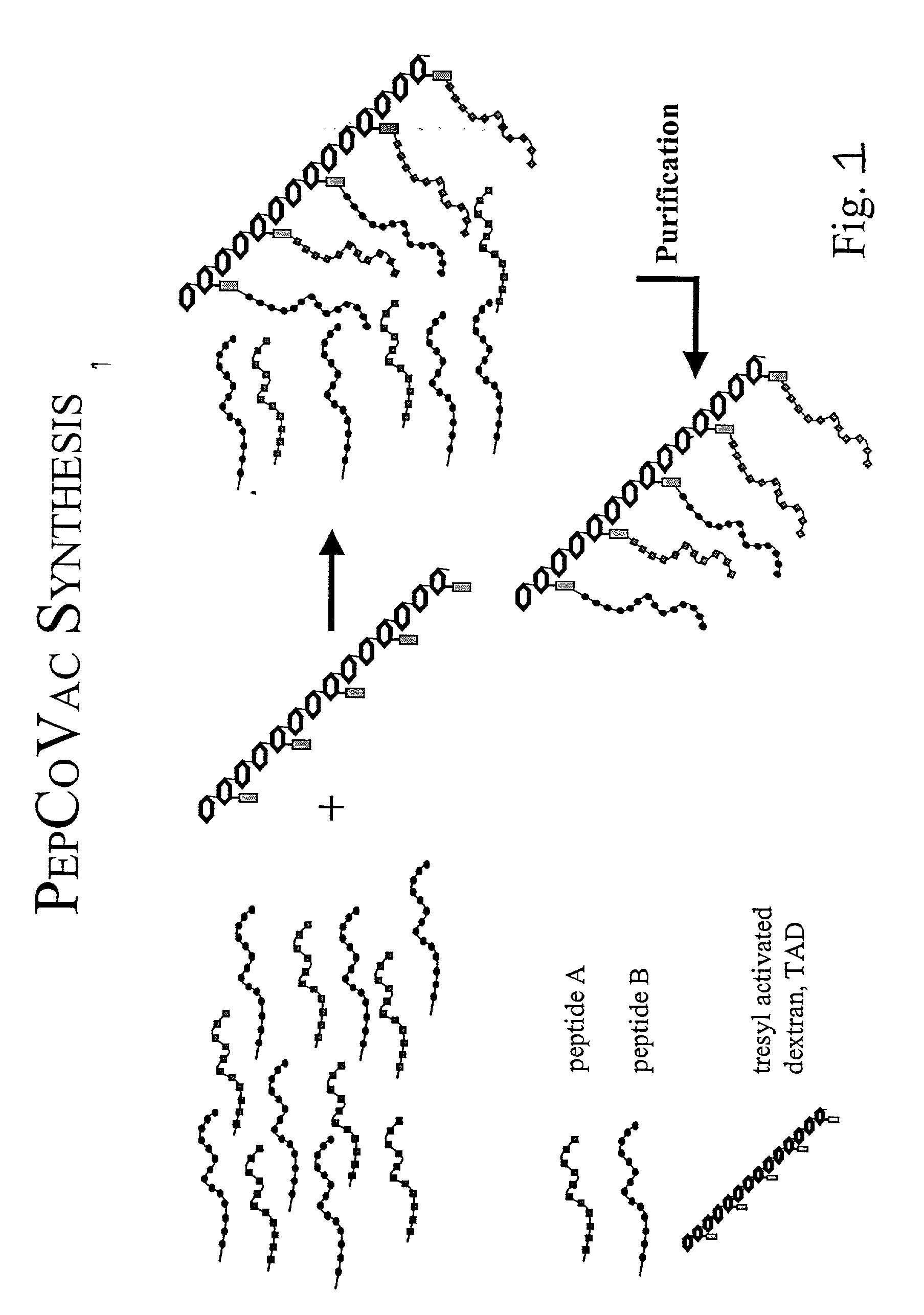Synthetic vaccine agents
a vaccine agent and synthetic technology, applied in the field of synthetic vaccine agents, can solve the problems of both prior art technologies suffering a number of drawbacks
- Summary
- Abstract
- Description
- Claims
- Application Information
AI Technical Summary
Benefits of technology
Problems solved by technology
Method used
Image
Examples
example 1
[0118] Synthesis of an A.beta. Peptide Copolymer Vaccine using Activated Poly-Hydroxypolymer as the Cross-Linking Agent.
[0119] Introduction.
[0120] A traditional conjugate vaccine consists of an antigen or hapten (e.g. in the form of a polypeptide antigen or hapten) coupled covalently to a carrier, such as a carrier protein. The antigen / hapten contains the B-cell or CTL epitope(s) and the carrier protein provides TH epitopes. However, most of the carrier protein will normally be irrelevant as a source for TH epitopes, since only a minor part of the total sequence contains the relevant TH epitopes. Such epitopes can be defined and synthesized as peptides of e.g. 9-15 amino acids. If these peptides are linked covalently to peptides containing the B-cell or CTL epitopes, e.g. via a multivalent activated polyhydroxypolymer as taught herein, a vaccine molecule that only contains the relevant parts of the antigen and the traditional carrier can be obtained. It is further possible to provid...
example 2
[0131] General Synthesis Peptide Copolymer Vaccines
[0132] TAD (10 mg) is dissolved in 100 .mu.l H.sub.2O and 1000 .mu.l carbonate buffer, pH 9.6, containing 1-5 mg peptide A (any immunogenic peptide of interest), 1-5 mg P2 (diphtheria toxoid P2 epitope) and 1-5 mg P30 (diphtheria toxoid P30 epitope) is added. The pH value is measured and adjusted to 9.6 using 0.1 M HCl. After 2.5 hours at room temperature the solution is freeze dried immediately hereafter. The freeze-dried product is dissolved in H.sub.2O and dialysed extensively against H.sub.2O or desalted on a gelfiltration column before the final freeze-drying. In case the peptides have lysine in the sequence the .epsilon.-amine in the lysine side chain should be protected by Dde using the Fmoc-Lys(Dde)-OH derivative in the synthesis (Gregorius and Theisen 2001, submitted). After coupling, hydrazine from an 80% solution is added to a final hydrazine concentration between 1-20% and the solution is incubated for another 30 min at ...
example 3
[0135] Vaccination and Efficacy Determination
[0136] Vaccinations
[0137] The immunogen of the invention is injected into a suitable animal species such as mouse, rat, guinea pig, rabbit, or monkey.
[0138] The immunogens can be mixed with a suitable adjuvant such as for example Freund's Adjuvant, ISA-51, aluminum-based adjuvants (aluminium phosphate or aluminium hydroxide, e.g. from Danfoss), Calcium Phosphate, QS21 (Antigenics), MF59 (Chiron Corp.), and Ribi (Glaxo SmithKline). Protein vaccines are usually administered 3-5 times, for example at weeks 0, 3, 6, 9, 12.
[0139] Antibody Titer Determination
[0140] Sera from vaccinated animals can be tested for specific antibodies by ELISA. 96-well Maxisorb plates (e.g obtained from Nunc, Life Technologies, Taastrup, Denmark) can be coated with a suitable volume (e.g. 50 ul) of either the antigen from which the 1.sup.st antigenic determinant is derived or with the antigenic determinant as such. This is done in a suitable buffer such as carbonat...
PUM
| Property | Measurement | Unit |
|---|---|---|
| Time | aaaaa | aaaaa |
| Composition | aaaaa | aaaaa |
| Molecular weight | aaaaa | aaaaa |
Abstract
Description
Claims
Application Information
 Login to View More
Login to View More - R&D
- Intellectual Property
- Life Sciences
- Materials
- Tech Scout
- Unparalleled Data Quality
- Higher Quality Content
- 60% Fewer Hallucinations
Browse by: Latest US Patents, China's latest patents, Technical Efficacy Thesaurus, Application Domain, Technology Topic, Popular Technical Reports.
© 2025 PatSnap. All rights reserved.Legal|Privacy policy|Modern Slavery Act Transparency Statement|Sitemap|About US| Contact US: help@patsnap.com

